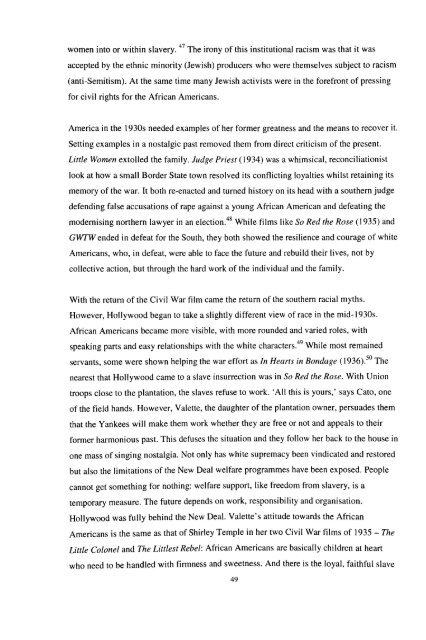Download (3483kB) - Greenwich Academic Literature Archive ...
Download (3483kB) - Greenwich Academic Literature Archive ...
Download (3483kB) - Greenwich Academic Literature Archive ...
- No tags were found...
You also want an ePaper? Increase the reach of your titles
YUMPU automatically turns print PDFs into web optimized ePapers that Google loves.
women into or within slavery. 47 The irony of this institutional racism was that it wasaccepted by the ethnic minority (Jewish) producers who were themselves subject to racism(anti-Semitism). At the same time many Jewish activists were in the forefront of pressingfor civil rights for the African Americans.America in the 1930s needed examples of her former greatness and the means to recover it.Setting examples in a nostalgic past removed them from direct criticism of the present.Little Women extolled the family. Judge Priest (1934) was a whimsical, reconciliationistlook at how a small Border State town resolved its conflicting loyalties whilst retaining itsmemory of the war. It both re-enacted and turned history on its head with a southern judgedefending false accusations of rape against a young African American and defeating themodernising northern lawyer in an election.48 While films like So Red the Rose (1935) andGWTW ended in defeat for the South, they both showed the resilience and courage of whiteAmericans, who, in defeat, were able to face the future and rebuild their lives, not bycollective action, but through the hard work of the individual and the family.With the return of the Civil War film came the return of the southern racial myths.However, Hollywood began to take a slightly different view of race in the mid-1930s.African Americans became more visible, with more rounded and varied roles, withspeaking parts and easy relationships with the white characters.49 While most remainedservants, some were shown helping the war effort as In Hearts in Bondage (1936). 50 Thenearest that Hollywood came to a slave insurrection was in So Red the Rose. With Uniontroops close to the plantation, the slaves refuse to work. 'All this is yours,' says Cato, oneof the field hands. However, Valette, the daughter of the plantation owner, persuades themthat the Yankees will make them work whether they are free or not and appeals to theirformer harmonious past. This defuses the situation and they follow her back to the house inone mass of singing nostalgia. Not only has white supremacy been vindicated and restoredbut also the limitations of the New Deal welfare programmes have been exposed. Peoplecannot get something for nothing: welfare support, like freedom from slavery, is atemporary measure. The future depends on work, responsibility and organisation.Hollywood was fully behind the New Deal. Valette's attitude towards the AfricanAmericans is the same as that of Shirley Temple in her two Civil War films of 1935 - TheLittle Colonel and The Littlest Rebel: African Americans are basically children at heartwho need to be handled with firmness and sweetness. And there is the loyal, faithful slave49
















